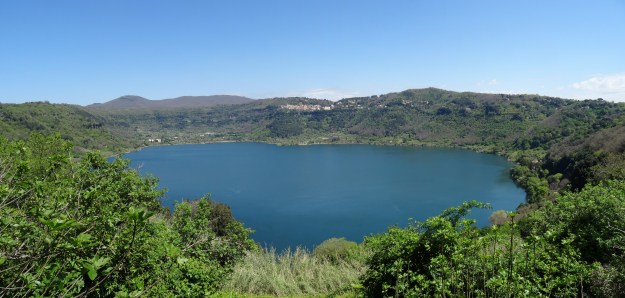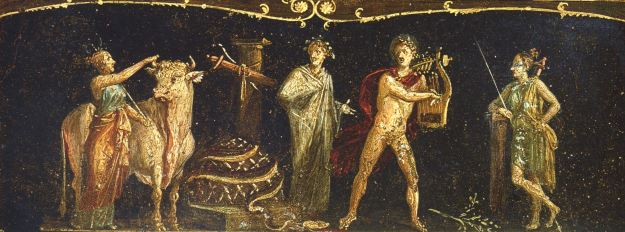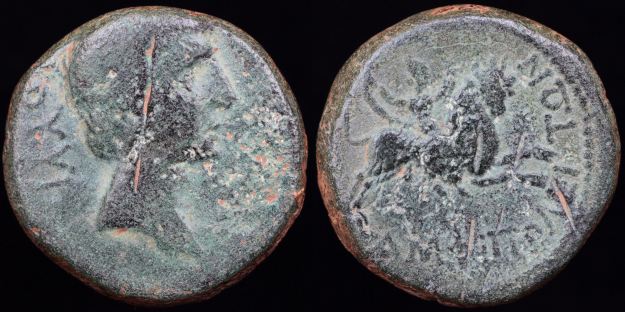You may remember, if you read my post on Taranis, how the Roman writer Lucan compared his cult to that of the “cruel” Diana of the Scythians. I wondered at the time who Diana of the Scythians was, and what was cruel about her cult.
The Scythian Diana he meant would seem to be the Taurian Artemis, a Greek goddess whose cult was, according to legend, imported from the Scythian tribes of the Black Sea. This cult seems to have been a popular one in Greece, with temples and dedications to Artemis Tauropolos in many places.
Later, the Romans tried to rationalize their own cult of Diana at Lake Nemi by associating it with the Greek one, thus explaining away the violence associated with it by making it foreign. All the myths of its origin emphasize how foreigners, usually Greek, brought the cult to Lake Nemi and dedicated the temple to Artemis.
Lake Nemi, of course, is best known from The Golden Bough, which describes how the chief priest, the Rex Nemorensis, was a runaway slave who won the position in single combat, and could lose it (and his life) to another like himself. This murderous route to promotion was no doubt why the Romans preferred to think of the cult as foreign.
Scythian Parthenos
While the name “Scythian” is a vague one, we do know that it included a group of tribes who lived in southern Siberia and were mentioned by the Greeks, Persians and Assyrians.
When the Greeks began to plant colonies around the Black Sea, they came into contact with Iranian nomads whom they called Scythians as well. While we know very little about their religion, the Greeks referred to one of their goddesses as Parthenos, or Virgin. This title was fairly common among Near Eastern goddesses; Artemis in particular was often called Virgin, along with Hekate.
Herodotus mentioned her and the human sacrifice that supposedly formed part of her cult in his Histories:
Among these, the Tauri have the following customs: all ship-wrecked men, and any Greeks whom they capture in their sea-raids, they sacrifice to the Virgin goddess1 as I will describe: after the first rites of sacrifice, they strike the victim on the head with a club; according to some, they then place the head on a pole and throw the body off the cliff on which their temple stands; others agree as to the head, but say that the body is buried, not thrown off the cliff. The Tauri themselves say that this deity to whom they sacrifice is Agamemnon’s daughter Iphigenia. As for enemies whom they defeat, each cuts his enemy’s head off and carries it away to his house, where he places it on a tall pole and stands it high above the dwelling, above the smoke-vent for the most part. These heads, they say, are set up to guard the whole house. The Tauri live by plundering and war.
Herodotus The Histories 4.103.1
There is evidence for her existence outside of Herodotus, however. In 1990 archaeologists dug up part of a black glazed vessel that had been dedicated to the goddess Parthenos. Her name survived, but the name of the dedicator is missing. It was found at Zhukovka, and nearby was a place called Parthenium, suggesting that the goddess had a shrine there. (Nearby was another, dedicated to Hercules, called Heracleum.) (Braund:19) Another, outside Chersoneus, suggests this was an important goddess.
Strabo mentions the temple at Chersoneus in his Geography, although he calls the goddess Artemis:
In this city is a temple of the Virgin, some goddess, after whom the promontory, which is in front of the city, at the distance of 100 stadia, is called Parthenium. It has a shrine of the goddess and a statue.
(Strabo Geography VII.4.2)
I don’t want to go into the religion of the Crimean peoples in detail, because I know very little about the subject, but it would seem that the Parthenos, despite her Greek name, was an indigenous deity – perhaps a hybrid goddess like the Celto-Roman ones (Brigantia, etc.).
Taurian Artemis and Iphigenia
However, Herodotus’ account probably influenced another famous account of the cruel goddess, in Iphigenia Among the Taurians:
I came to Aulis; held up high over the altar, I, the unhappy one, was about to die by the sword; but Artemis gave the Achaeans a deer in exchange for me and stole me from them; conducting me through the bright air, she settled me here in the land of the Taurians. A barbarian rules this land of barbarians: Thoas, who runs as quickly as the flight of birds, and so he received his name for his swiftness of foot. Artemis has made me the priestess in this temple. [35] Here I begin the rites, which the goddess delights in, of a banquet noble in name only—I am silent as to the rest, for I fear the goddess— [for I sacrifice, by a custom of the city established earlier, any Hellene who comes to this land.] But others carry out the sacrifices, not to be spoken of, within the temple of the goddess.
The conclusion tells how her brother Orestes brings Iphigenia back to Athens, along with the cult of Taurian Artemis. (Just as the end of The Eumenides explains how the Furies came to have a temple in Athens; Euripides liked to explain why such fearsome cults could flourish in the centre of civilization.)
According to the play, the two escape from Tauri and bring Artemis’ statue to Attica, placing it in a temple at Halai Araphenides. To appease the goddess,
…whenever the people keep the festival, let a sword be held to a man’s throat and draw out blood, in atonement for your sacrifice, so that the goddess may have her honors, and holiness is revered.
There were other temples to Artemis Tauropolos around Greece, including the island of Ikara, Artemida, and Brauron, a major site for Artemis’ cult. (According to Euripides, Iphigenia went to Brauron, where she became a priestess, and was buried there. Some versions of the story end with the apotheosis of Iphigenia, and she was given offerings in the many places that claimed to have her tomb. I will be writing further about Iphigenia in another post.)
Tauropolos could mean that she was goddess of Tauris, or protector of Tauris, or else that she was somehow connected to bulls – either killing them, using them as draft animals, or taming them. There was a Tauropolia festival at Athens.
Diana at Nemi
The cult of Diana Nemorensis was an ancient one, but the Romans linked it to the Greek cult of Artemis Tauri, perhaps because of the violence associated with it. The three myths of its origin all involve people fleeing from killing: Hippolytus, who was killed by his father; Thoas, escaping a massacre; and Orestes.
Pausanias describes how one of them, Hippolytus, went to Italy and created the sanctuary for Artemis:
On coming to life again he refused to forgive his father rejecting his prayers, he went to the Aricians in Italy. There he became king and devoted a precinct to Artemis, where down to my time the prize for the victor in single combat was the priesthood of the goddess. The contest was open to no freeman, but only to slaves who had run away from their masters.
Pausanias Description of Greece II.27.4
Strabo elaborated on the foreigness of the cult, as well as providing the details that inspired Frazer’s most famous passage, in his own description of the Arican cult:
They say that it is consecrated to Diana Taurica, and certainly the rites performed in this temple are something barbarous and Scythic. They appoint as priest a fugitive who has murdered the preceding priest with his own hand. Apprehensive of an attack upon himself, the priest is always armed with a sword, ready for resistance. The temple is in a grove, and before it is a lake of considerable size. The temple and water are surrounded by abrupt and lofty precipices, so that they seem to be situated in a deep and hollow ravine. The springs by which the lake is filled are visible. One of these is denominated Egeria, after the name of a certain divinity; however, their course on leaving the lake is subterraneous, but they may be observed at some distance, when they rise to the surface of the ground,
Strabo Geography V:3:12
Strabo’s description emphasizes the dramatic site, three miles outside the town of Arica, on the shore of Lake Nemi, a circular lake called speculum Dianae, Diana’s mirror. Votive offerings dating back as far as the fourth century BCE suggest that women went their for safe births, or to conceive, while men desired success at hunting.
Diana, like Artemis, was a goddess of wild places, so perhaps it is fitting that her cult remained apart from the official Roman temples, although a temple to her did exist within the city, on the Aventine Hill.
A final note: throughout this post I’ve noted how both Greeks and Romans tried to make Artemis/Diana’s cult “foreign” to mitigate its bloodiness. But the struggle for succession at Arica finally turned into that most Roman of violent pastimes: a gladitorial combat. (I should point out that some scholars have argued Frazer invented the whole story.)
PS – I also wanted to mention that the playwright Aeschylus described the priestesses of the Taurian Artemis as bee-keepers (melissonomoi) “at hand to open the house of Artemis.” The priestesses of Artemis at Ephesus were called Melissae, Bees, which is probably where he got the idea.
References and Links
Bilde, Pia Guldager 2005: “What was Scythian about the “Scythian Diana” at Nemi?” Archeologičeskie Vesti 12 (St Petersburg): 209-217. (Academia.edu)
Braund, David 2018: Greek Religion and Cults in the Black Sea Region: Goddesses in the Bosporan Kingdom from the Archaic Period to the Byzantine Era, Cambridge University Press. (Google Books)
“Rex Nemorensis” from the Encyclopedia Romana
ToposText on the temple of Diana Nemorensis
Description of the temple of Artemis Tauropolos at Artemida
Herodotus on the Scythians (Livius.org)
History of Crimea (Wikipedia)
Cult of Taurian Artemis (Theoi.com)
The bloodthirsty goddess: Artemis Tauropolos and Ortheia (WorldHistory.Biz)
For the source of the picture at the top, click here.





There was a Celto-Scythian tribe in far Eastern Europe. The Celtic women were buried when dead like other Balkan Celts, so they seemed to keep their customs. I just thought of them from the link between Taranus and Scythians, even though they probably have nothing in common. But scholars in Iberia and the Balkans are really speedily filling a lot gaps in our knowledge of the Celts. I have a paper or two on the Scythian-Celtic connection in English. (Also a great one by Polish researchers about the linguistics of the Alci (Celtic, not Germanic, it’s found in Iberia along with another name for the Gods, Dies Equehuna) and one about a diversion of Indo-European languages about 4,000 years ago that show up in Celtic, Germanic and Finnish, with many about religion and Lug/ Odin that’s fascinating.) It’s all at academia website if you follow Indo-European language. A couple papers on Hittite religion just came out – that’d be an interesting religion to try to piece together!
Anyway, love your blog!
LikeLiked by 1 person
Thanks for letting me know – I’ll check that out. The Hittites are another fascinating people so I’ll have to look at that as well.
LikeLiked by 1 person
Pingback: Scythian Diana – who was she? — We Are Star Stuff | Die Goldene Landschaft
Like Gullveig Press, I was also reminded of the Celts custom of cutting off the head of those defeated in war, and preserving them. I was also reminded of Badh? with her links to cattle. I’m also probably misremembering, but years and years ago as a girl, I think I read something a Time Life book which suggested that the Celts had greater links to Eurasia, only picking up on the Greek theme as they moved West. Fascinating stuff 😀
Excellent article as always. Thank you!
LikeLiked by 1 person
Yes, they did like their heads. There’s a great Irish story about how someone was struck by one and killed.
It’s the Morrigan who’s linked to cows, but they are sister goddesses so it’s not much of a difference.
The Celts probably did start in Central Europe or Western Asia and moved west. The archaeology is fascinating stuff.
LikeLiked by 1 person
Thanks for clarifying. And yes, I completely agree, archaeology is fascinating stuff!
LikeLiked by 1 person
Pingback: Iphigenia, the Heroines and Hecate | We Are Star Stuff